11 Steps To Optimizing Human Capital Allocation
Efficient human capital allocation has become a core driver of competitive advantage – and business survival.

With rapid advancements in technology and shifting industry demands, organizations must optimize the placement and development of their workforce in order to remain agile and responsive.
This article outlines eleven actionable steps to ensure that human capital is strategically allocated to maximize productivity, engagement, and growth – even as requirements change at pace.
Step 1: Establish a skills- and tasks-based framework 🧱
To build an effective human capital allocation strategy, you need a framework that makes it easy to connect people (i.e. human capital) with work. We recommend using the language of skills and tasks.
To start, you need to develop a consistent skills taxonomy with clear, standardized definitions for every skill, including core skills applicable to all roles, and specialized skills unique to specific domains. This will give you a structured, hierarchical view of all relevant skills, competencies, and knowledge areas relevant to your organization.
AI can help you ensure skills are commonly defined, and also automatically connected between HR systems, reducing the effort of maintenance and manual mapping.
Break work into component tasks to uncover, from there, the skills you actually need... and where parts of work could potentially be automated or augmented by AI.
“Using skills as that currency allows you to hire faster; and hire better, because you're looking at the skill, not necessarily the individual or the jobs that they had before. It allows you to be relevant in the market and to move with pace.” – Andi Zyka, Director, Employee Success Product Management, Salesforce
✨ Learn more about building a skills taxonomy.
Step 2: Conduct a comprehensive needs analysis 🔎
Now you can work out what you need. Build and maintain a dynamic job architecture for your business, based around skills and tasks.
Rather than rigidly defining positions, identify the core skills, competencies, and responsibilities essential for achieving organizational goals. Role definitions should then evolve as needs shift, ensuring your organization is set up to be truly responsive in how it assigns talent to roles.
You should also consider how you can link your job architecture with labor market insights, to get a richer understanding of how jobs, tasks and skills are changing, keep up with competitors, and make even more informed decisions.
“Being skills-first, I think, is a great way to kind of preserve where we’re going in the future. So ditch the traditional job description, the rigidity of those, and really think about maximizing the investment on the skills side.” – Elle Lebourg, Global Head of Talent Acquisition, Hilti.
✨ Read more about the power of a dynamic job architecture.
Step 3: Build a skills inventory 🗄️
Now it’s time to identify gaps and emerging skills needs. Assess your current workforce capabilities (and those of your wider talent pool) against current and future requirements. Look beyond present needs to forecast emerging skills that may become critical, like advanced digital literacy, data analysis, ESG, or cross-functional collaboration.
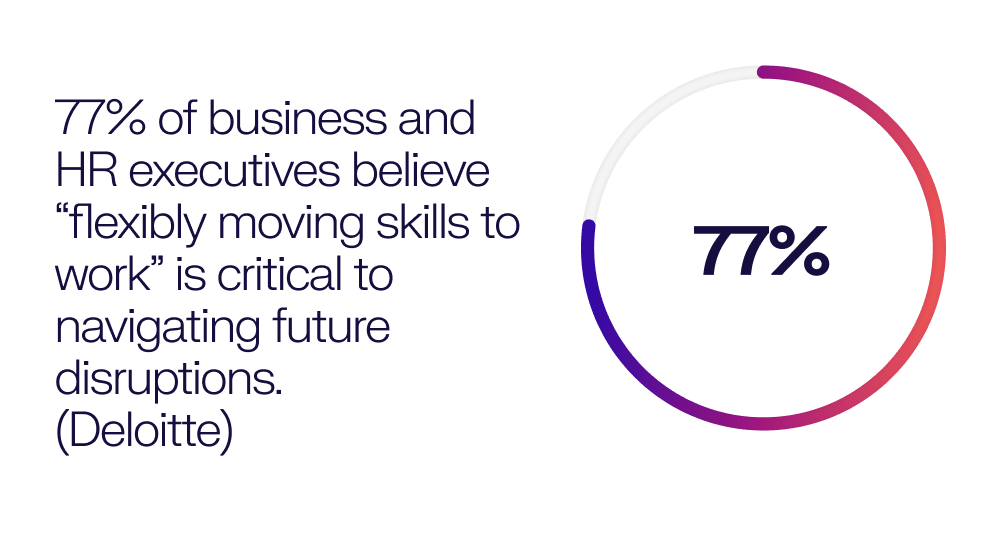
Use a centralized platform (an extension of your Talent CRM, essentially) to gather and store comprehensive data on the skills and aspirations of your entire employee population (potentially using AI to reduce manual effort).
AI can also help you improve the quality of your data and bridge gaps, such as skills listed on LinkedIn profiles but not on employee profiles. AI can also work out if there are ‘adjacent’ skills people are likely to have, or be able to learn, based on the rest of their skills profile. It can also ensure people’s skills profiles automatically update when they learn something new.
“Artificial intelligence is going to be critical in order to make sure that we are going to be able to understand the different set of skills that a person has, and that we can translate and understand those skills.” – Fernando Bellon, Head of Talent Acquisition, BBVA
Add data from alumni, existing job candidates, previous applicants, and potential candidates, to create the widest possible skills data set, representative of your whole ‘talent universe’.
Maintaining a detailed and robust skills inventory helps you understand the full potential of your workforce, and allows you to deploy the right talent quickly and accurately – matching the needs you’ve identified with the supply (or potential supply) you have at your disposal.
By looking at your skills and tasks needs (Job Architecture) and skills supply side by side, you will see the specific areas where development, redeployment, or new hires are necessary to close gaps… ensuring that human capital allocation is guided by real-time insights.
✨ Learn more about connected skills intelligence.
Step 4: Embrace ethical AI for talent matching 🤝🏽
AI is your not-so-secret weapon for efficient and effective talent matching. Use AI-powered platforms to organize your supply and demand data, and then easily “match” employee (or candidate) skills with job tasks or roles.
Quickly identify talent whose skills, experiences, and aspirations align with open positions, or who could be reskilled or redeployed to cover critical tasks.
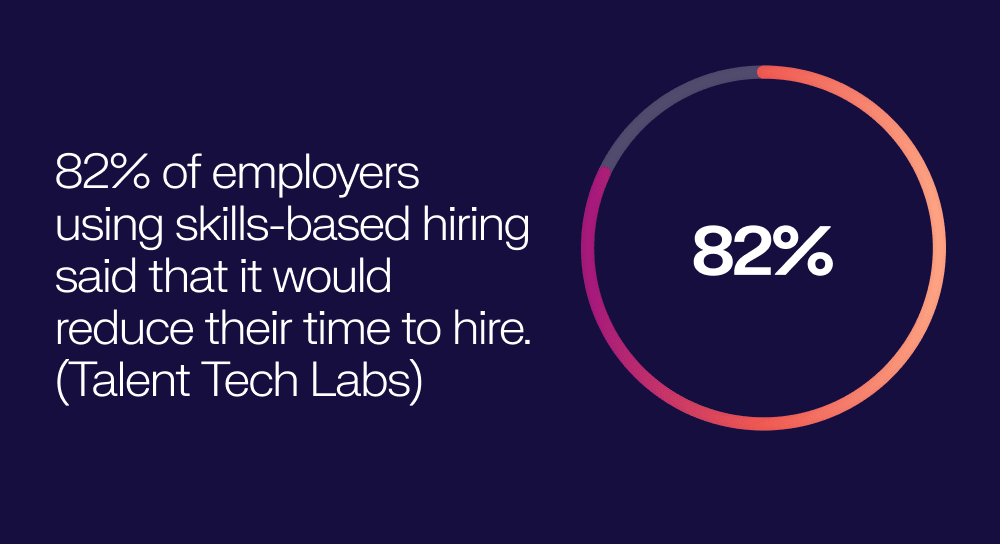
Ethical, explainable AI will score candidates against a job profile, providing an objective assessment of their fit, and rank them based on their skills, industry, seniority, and the size of companies they’ve worked at. Recommendations should always be accompanied with an explanation of why someone is the best choice, and clarity around the mix and weight of the factors considered.
This matching not only accelerates the hiring and redeployment process but also improves the quality of hire, reduces bias in hiring decisions, improves retention and tenure rates, and enhances job satisfaction, by aligning employees with roles that fit their strengths.
✨ Read more about using AI in HR.
Step 5: Implement talent mobility programs 🏃
It’s frequently the case that the skills you need to close critical gaps are actually already prevalent in your existing workforce. It’s also true that employee attrition can often be avoided if people could more easily move roles within the organization rather than having to look externally.
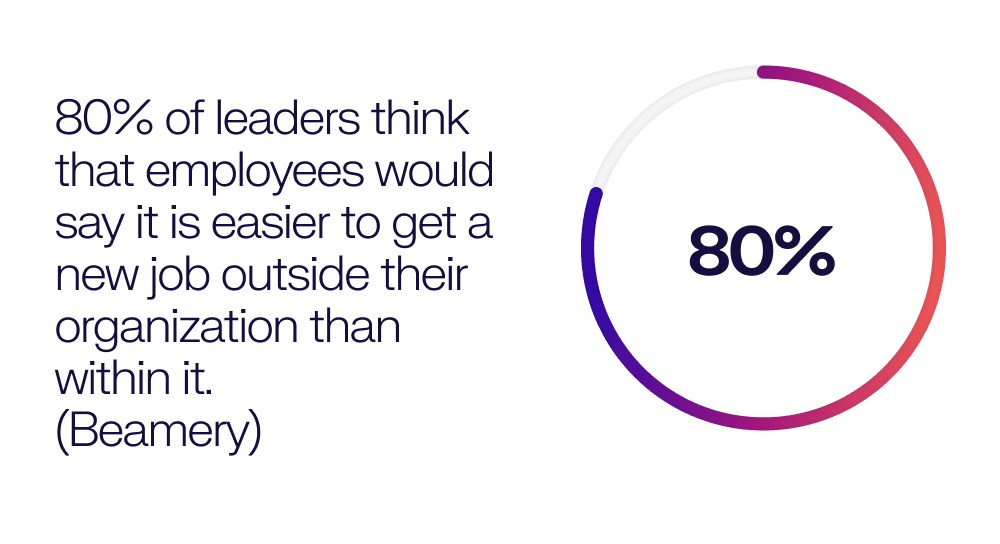
Promote internal talent mobility to fill gaps, enhance workforce agility, and increase employee engagement. Once again, AI-powered technology can recommend the ideal internal candidate for a role, based on comprehensive, real-time skills and task data – ensuring total agility while maintaining fairness.
Encourage cross-departmental transfers and project-based roles to keep employees challenged and invested in their career growth, while maintaining agility.
Skills-based organizations are 107% more likely to place talent effectively, 52% more likely to innovate, and 57% more likely to anticipate change and respond effectively and efficiently. (Deloitte)
Supporting internal movement reduces hiring costs, speeds up onboarding, and boosts retention by providing new opportunities within the company.
✨ Learn more about skills-based talent mobility.
Step 6: Develop a succession planning strategy 🔮
Succession planning, done well, helps organizations prepare for inevitable talent transitions in critical roles.
Identify high-potential employees early, based on their skills, potential and aspirations, and offer up targeted development programs to prepare them for future leadership.
AI-powered platforms can nudge you towards people most likely to leave, and suggest the best ways to retain them. You can keep someone engaged while also developing them for future skills needs (or, at least, have someone primed to take over if they do leave).
“We talk about skills, but you tend to talk a lot about skills at the hiring stage… what are the critical skills within your entire organization? Because if you then start to think about critical skills, you start to talk about critical roles. And I think that just starts to help you be much more planful and prepared for the direction of travel that your business is going through.” – Katharine Rooney, VP Talent Attraction & Acquisition, Mimecast
✨ Read our top tips for better succession planning.
Step 7: Prioritize upskilling & reskilling initiatives 📖
In a world of rapidly changing skills demands, learning and development has never been more important. The World Economic Forum has estimated that automation will displace 85 million jobs by 2025, and 40% of core skills will change for workers.
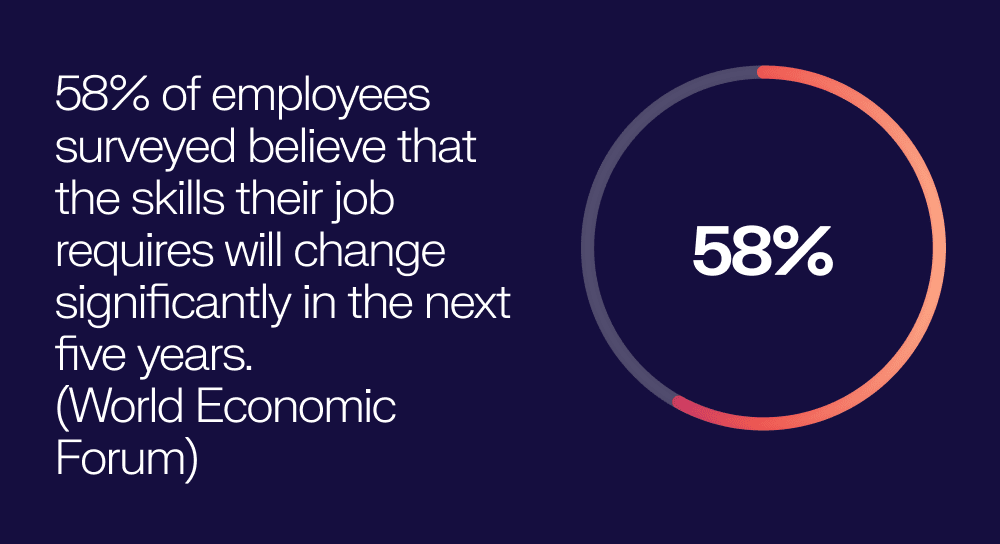
Upskilling and reskilling are essential for keeping pace. Invest in learning and development programs to help employees acquire skills that align with strategic objectives and future tasks/roles, and as part of the internal mobility and succession planning initiatives mentioned above.
The foundation of skills and task data you have built up will help you pinpoint which critical skills are most lacking across teams, and who to reskill to prepare your organization for the future.
Skills-based organizations are 98% more likely to have a reputation as a place to grow and develop, and 98% more likely to retain high performers. (Deloitte)
Offer a blend of self-paced learning, mentorship, and formal training to make growth accessible and engaging. AI can help you tailor the format as well as the content of learning programs, to ensure maximum engagement.
✨ Learn more about improving L&D in the age of AI.
Step 8: Use data analytics for more informed decision making 📊
Analytics enables organizations to make data-driven decisions about workforce planning and allocation.
Use analytics, alongside that all-important skills data, to track performance metrics, identify high-performing employees, and understand turnover patterns. Consider how you can embed these insights inside the tools you use every day, or surface them to leaders and managers in the flow of work – to make your organization even more agile and responsive.
Predictive analytics around tasks can also help you forecast talent shortages, equipping leaders to plan proactively rather than reactively.
Bringing work data into one place – a single source of truth – not only reduces the time it takes to make decisions, but makes those decisions easier to make, with the bigger picture in mind.
“When you’re looking at headcount, when you’re looking at forecasting, when you’re looking at availability of talent, that all has to be done in one piece.” – Nigel Williams, Global Talent Acquisition Leader, BlackRock
Step 9: Cultivate a culture of flexibility & agility 🤸🏾♀️
An agile workforce is adaptable and prepared to pivot as needed. Fostering a culture that values flexibility and encourages employees to embrace new challenges can boost resilience and innovation.
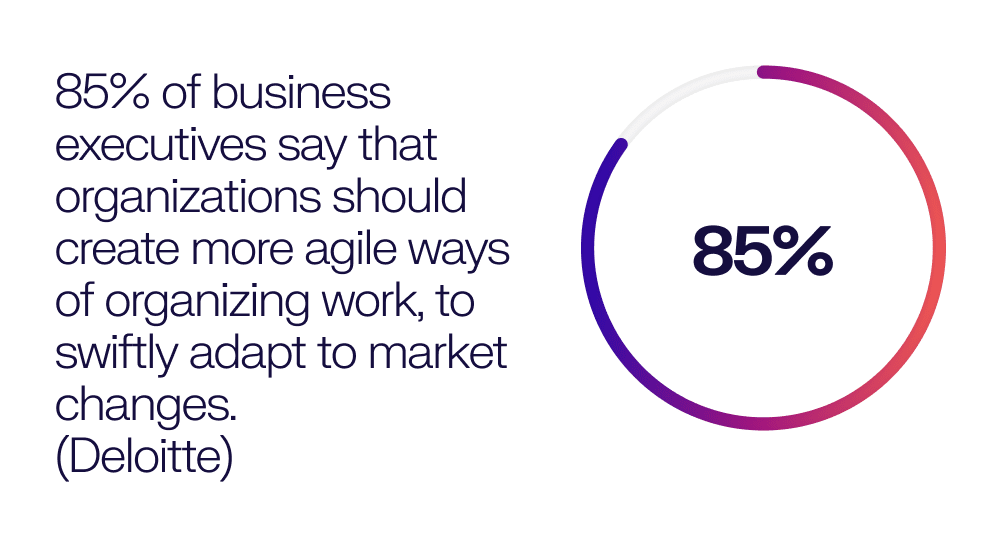
By removing rigid role boundaries (defining jobs based on tasks and skills) and supporting adaptable work practices, organizations can respond to changes without the need for major structural shifts.
Step 10: Promote cross-functional collaboration 💑
Cross-functional teams bring together diverse skills and perspectives, fostering innovation and making it easier to deploy human capital effectively.
Encourage employees to work on cross-departmental projects, fostering a collaborative mindset and enabling leaders to mobilize diverse expertise when addressing complex problems or new initiatives.
It’s also a good idea to bring HR teams together, along with other departments, to ensure you are best able to plan for the workforce of tomorrow.
“What we started to do and that’s worked really well is to work with our counterparts in finance, in wider HR, in L&D and talent management to understand not just “what do we need to hire and what are our retention rates”, but: how many people are we developing through the business, and what do we need to replace those people with, and what are the skills going to be that we need in five years time, and where can I start looking for those now? So that we can be quite intentional about what we need and when; so we can really start building up those pipelines that will add value.” – Lara Farrell, Global Head of TA Programmes, Hilti
Step 11: Establish KPIs & measure outcomes regularly ⏱️
Measure the impact of your human capital allocation strategy by setting key performance indicators (KPIs) related to productivity, skill growth, internal mobility rates, and retention.
Regularly assess the results of these metrics to determine if the allocation strategy aligns with your business objectives. Consistent feedback loops and performance evaluations allow leaders to adapt and refine approaches as organizational needs evolve.
Make Better People-Related Decisions 💙
41% of HR leaders agree their workforce lacks required skills, 50% agree their organization does not effectively leverage skills, and 62% agree that uncertainty around future skills poses a significant risk. (Gartner)
A well-aligned human capital strategy leads to improved productivity, higher employee satisfaction, and a more agile organization prepared to thrive in today’s competitive landscape.
Technology – particularly AI – is making it easier than ever to build a dynamic “skills ecosystem” that allows you to find, deploy and redeploy the right people into the relevant roles or training or career paths.
“The difference now is that there is a tech enablement opportunity that we didn’t have before. We were all probably looking at spreadsheets and then they'd become obsolete… but now, having the ability to know what skills you have in your company, the ability to then predict what skills you’re going to need in the future, and filling the gap, is really how your company is going to grow or change or transform.” – Jacqui Canney, Chief People Officer, ServiceNow
Now is the time for leaders to take proactive steps, creating a skills-based workforce that is both ready for current demands and adaptable to future shifts.
✨ Read more about the steps to becoming a skills-based organization.
Beamery provides a comprehensive approach to human capital allocation through a customized, AI-driven talent platform.
Our solution adapts to your organization, learning from your data to build a dynamic skills taxonomy and task intelligence layer that integrates seamlessly with existing systems like Workday and SAP.
This unified platform translates and normalizes skills data, creating a shared language across various roles and departments, so you can strategically align talent with business goals.
Decision-makers gain real-time insights into skills and tasks, while recruiters and managers can easily access a holistic view of all candidates.
By guiding talent toward roles that fit their skills, even those they may not have considered, we support a seamless and adaptable recruitment journey, empowering you to optimize talent deployment at every level.